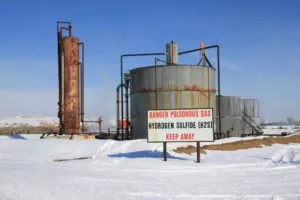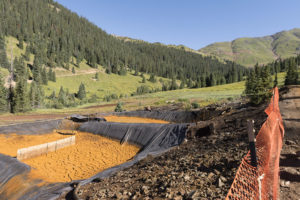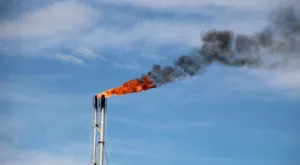Under authority conveyed by the Emergency Planning and Community Right to Know Act (EPCRA), in 1997 the Environmental Protection Agency (EPA) required the mining industry to begin reporting its toxic releases in 1998.
In 1998, the National Mining Association, the trade association that represents large, multinational mining companies in the United States, and Barrick Gold, a Canadian mining company, began a campaign to overturn the EPA’s decision — to eliminate or limit the public’s right to know about the mining industry’s toxic releases.
The following two court cases are the most significant parts of that effort.
NMA v. EPA
Industry association sues to eliminate the public’s right to know about mining’s toxic releases
In 1998, the National Mining Association sued the EPA in Federal District Court of Colorado (Civil No. 97-N-2665; D. Colo.), challenging the Toxics Release Inventory in three several ways, including:
- NMA claimed that EPA had no authority to regulate mining operations under the Emergency Planning and Community Right to Know Act (EPCRA). The District Court rejected this argument, holding that mining facilities are not exempt from the law.
- NMA argued that mining facilities shouldn’t have to report toxic chemicals released into leach pads (e.g. cyanide). Again, the District Court rejected the NMA argument, holding that mining operations must report toxic releases to leach pads and other containment units.
- NMA argued the mining industry didn’t have to report toxic materials resulting from the “extraction or beneficiation” of ores. These toxics are originally contained within the mined ore and waste rock that a mining company releases when it unearths the material and separates the target mineral (e.g. gold) from the ore.
- NMA claimed that extraction and beneficiation of ore didn’t constitute “processing” as defined by EPCRA and categorized by the EPA. NMAs claimed that the toxics in question are “naturally occurring,” i.e. the mining industry didn’t create the toxics in question, so they shouldn’t be required to report them as toxics.
Court rules much mining waste isn’t “processed”
The Court initially accepted the NMA’s third argument and prohibited the EPA from requiring the mining industry to report waste from “extraction and beneficiation” under EPCRA’s definition of the term processing.” But, the court ultimately clarified that, while “extraction and beneficiation” may not be processing, that didn’t mean EPCRA prohibited EPA from requiring the reporting of toxics resulting from such activities.
Naturally occurring toxics: a threat for which industry is responsible
Although it is true that the mining industry doesn’t actually create many of the toxics that it reports under the TRI, it is responsible for the threat posed by those toxics.
If the companies didn’t extract these toxics, and then dump them as mine waste, they wouldn’t be able to pollute surface water, groundwater, and drinking water.
Industry must still report naturally occurring toxics
Based on the court’s clarification, the EPA sent a letter notifying the NMA that there would be no changes in reporting requirements until the agency could undertake a rulemaking to address the issue.
But, in a July 2, 2001 letter to the EPA, the NMA stated that it intended to ignore the EPA’s directives, and that it would not report toxic releases to the public according to its own interpretation of the Court’s ruling.
In January 2003, the NMA filed a motion with the Court to modify the 2001 injunction that prevented the EPA requiring reporting of certain mining waste under the term “processing,” to make clear to the Environmental Protection Agency that — absent further comment and rulemaking — the agency cannot require metal mines to report toxics resulting from “extraction or beneficiation” of ores.
On May 13, 2004, the Court denied the NMA’s motion and determined that the EPA can require metal mines to report without a rulemaking on the issue.
Barrick v. Whitman — the “de minimis” exemption
In the 1999, Barrick Gold (world’s largest gold producer) sued EPA in the Federal District Court of the District of Columbia (Barrick Goldstrike Mines, Inc. v. Whitman Civ. Action No. 99-958), to limit the public’s right to know about toxic mining pollution in several ways:
- Barrick argued that toxic chemicals that change into a slightly different form shouldn’t be reported. The Court rejected Barrick’s argument, requiring the industry to report all toxic chemicals that change forms.
- Barrick argued that toxic chemicals released as part of tailings shouldn’t be reported. The Court rejected Barrick’s argument, requiring that all toxics released in tailings were reportable under the TRI.
- Barrick claimed that mining companies don’t have to report toxics contained within waste rock if the toxics fall below a certain “de minimis” concentration. The court agreed with Barrick on this point.
As part of the regulations that guide TRI reporting, the EPA established a reporting exemption, known as “de minimis,” for minute concentrations of toxics that constitute no threat to the environment or to public health. Barrick argued, and the court agreed, that the “de minimis” exemption should apply to toxics contained within waste rock.
De minimis: dismissing mining toxics in waste rock
Including toxics within waste rock under the “de minimis” exemption violates the spirit of the exemption. Even small concentrations of toxics add up quickly when dumped in prodigious quantities: more than half of the mining industry’s billions of pounds of toxic releases now go unreported as result of the District Court’s decision.
And toxic chemicals contained in waste rock create significant environmental problems.
For example, waste rock piles at the Zortman-Landusky mine complex in Montana are contaminating groundwater and surrounding rivers and streams with acid runoff and heavy metals — and will continue to do so for hundreds, and perhaps thousands, of years.
Biotoxins Still Must Be Reported
Persistent Bioaccumulative Toxins (PBTs) such as lead, mercury and arsenic do not qualify for the “de minimis” exemption, no matter their concentration, and must be reported.
Industry Must Still Report
The EPA has said that it plans to write a new rule clarifying reporting obligations as a result of these lawsuits. However, until then, the mining industry must report all its toxics releases except those that fall below the de minimis exemption.



